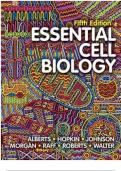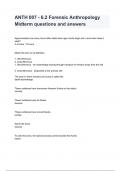, CHAPTER 1 Cells: The Fundamental Units of Life
UNITY AND DIVERSITY OF CELLS
1.1.a Compare, with examples, some ways in which cells may vary in appearance and function.
1.1.b Outline, with examples, ways in which cells share a basic fundamental chemistry.
1.1.c Explain how the relationship between DNA, RNA, and protein—as laid out in the central dogma—makes the self-
replication of living cells possible.
1.1.d Summarize how the processes of mutation and selection promote the gradual evolution of individuals best suited for
survival in a wide range of habitats.
1.1.e Explain how differentiated cell types can vary widely in form and function despite having the same genome se-
quence.
CELLS UNDER THE MICROSCOPE
1.2.a List the three tenets of cell theory and explain their ramifications for the study of cell biology.
1.2.b Contrast light microscopy, super-resolution fluorescence light microscopy, and electron microscopy in terms of the
cell components that can generally be distinguished using each.
1.2.c Compare how samples are prepared for light versus electron microscopy and explain how these preparations affect
whether the technique can be used for viewing living cells or tissues.
THE PROKARYOTIC CELL
1.3.a Describe the structural differences between prokaryotes and eukaryotes.
1.3.b Analyze how eukaryotic cells and organisms rely on the function of prokaryotic cells and their descendants.
1.3.c Compare prokaryotes and eukaryotes in terms of their relative preponderance on Earth, their range of habitat, and
their tendency toward multicellularity.
1.3.d Justify the division of prokaryotes into bacteria and archaea.
THE EUKARYOTIC CELL
1.4.a State the function of the nucleus and describe its structural features.
1.4.b Explain how the structure of the mitochondrion supports its function.
1.4.c Outline the evolution of mitochondria and chloroplasts and cite the evidence for these origins.
1.4.d Explain how chloroplasts and mitochondria cooperate as plant cells convert light energy into chemical energy.
1.4.e Compare the function of lysosomes and peroxisomes.
1.4.f Compare the structure, location, and function of the endoplasmic reticulum and Golgi apparatus.
,1.4.g Outline the role that transport vesicles play in endocytosis, exocytosis, and the movement of materials between one
membrane-enclosed organelle and another.
1.4.h Relate the location of the cytosol with respect to the cell’s membrane-enclosed organelles.
1.4.i List the three major filaments of the cytoskeleton and contrast the roles they have in animal cells.
1.4.j Outline the role the cytoskeleton has in plant cells.
1.4.k Describe the ancestral cell that likely engulfed the aerobic bacteria that gave rise to mitochondria and explain why
this event is thought to have preceded the acquisition of chloroplasts.
MODEL ORGANISMS
1.5.a Review why scientists study model organisms.
1.5.b Compare E. coli, S. cerevisiae, and A. thaliana and list the types of discoveries made by studying each.
1.5.c Compare flies, worms, fish, and mice as model organisms and name a benefit of studying each.
1.5.d Review the benefits of studying cultured human cells.
1.5.e Assess the relationship between genome size and gene number.
1.5.f Explain the significance of homologous genes and proteins.
1.5.g Summarize the roles played by the nucleotide sequences contained in an organism’s genome.
1.5.h Outline an experiment that would allow investigators to determine whether proteins from different eukaryotes are
functionally interchangeable.
MULTIPLE CHOICE
1. Living systems are incredibly diverse in size, shape, environment, and behavior. It is estimated that there are between
10 million and 100 million different species. Despite this wide variety of organisms, it remains difficult to define what it
means to say something is alive. Which of the following can be described as the smallest living unit?
a. DNA
b. cell
c. organelle
d. protein
ANS: b DIF: Easy REF: 1.1 OBJ: 1.1.b Outline, with examples, ways in which cells share a basic fundamental chemis-
try. MSC: Understanding
2. The central dogma provides a framework for thinking about how genetic information is copied and used to produce
structural and catalytic components of the cell. From the choices below, select the order of biochemical processes that
best correlates with the tenets of the central dogma.
a. replication, transcription, translation
b. replication, translation, transcription
c. translation, transcription, replication
d. translation, replication, transcription
, ANS: A DIF: Easy REF: 1.1 OBJ: 1.1.c Explain how the relationship between DNA, RNA, and protein—as laid out in
the central dogma—makes the self-replication of living cells possible. MSC: Understanding
3. Proteins are important architectural and catalytic components within the cell, helping to determine its chemistry, its
shape, and its ability to respond to changes in the environment. Remarkably, all of the different proteins in a cell are
made from the same 20 __________. By linking them in different sequences, the cell can make protein molecules
with different conformations and surface chemistries, and therefore different functions.
a. nucleotides
b. sugars
c. amino acids
d. fatty acids
ANS: C DIF: Easy REF: 1.1 OBJ: 1.1.b Outline, with examples, ways in which cells share a basic fundamental chem-
istry. MSC: Remembering
4. Which statement is NOT true about mutations?
a. A mutation is a change in the DNA that can generate offspring less fit for survival than their parents.
b. A mutation can be a result of imperfect DNA duplication.
c. A mutation is a result of sexual reproduction.
d. A mutation is a change in the DNA that can generate offspring that are as fit for survival as their parents are.
ANS: C DIF: Easy REF: 1.1 OBJ: 1.1.d Summarize how the processes of mutation and selection promote the gradual
evolution of individuals best suited for survival in a wide range of habitats. MSC: Analyzing
5. Changes in DNA sequence from one generation to the next may result in offspring that are altered in fitness
compared with their parents. The process of change and selection over the course of many generations is the
basis of
a. mutation.
b. evolution.
c. heredity.
d. reproduction.
ANS: B DIF: Easy REF: 1.1 OBJ: 1.1.d Summarize how the processes of mutation and selection promote the gradual
evolution of individuals best suited for survival in a wide range of habitats. MSC: Understanding
6. Select the option that BEST finishes the following statement: Evolution is a process
a. that can be understood based on the principles of mutation and selection.
b. that results from repeated cycles of adaptation over billions of years.
c. by which all present-day cells arose from 4–5 different ancestral cells.
d. that requires hundreds of thousands of years.
ANS: A DIF: Moderate REF: 1.1 OBJ: 1.1.d Summarize how the processes of mutation and selection promote the
gradual evolution of individuals best suited for survival in a wide range of habitats. MSC: Analyzing
7. Select the option that correctly finishes the following statement: A cell’s genome
a. is defined as all the genes being used to make protein.
b. contains all of a cell’s DNA.







